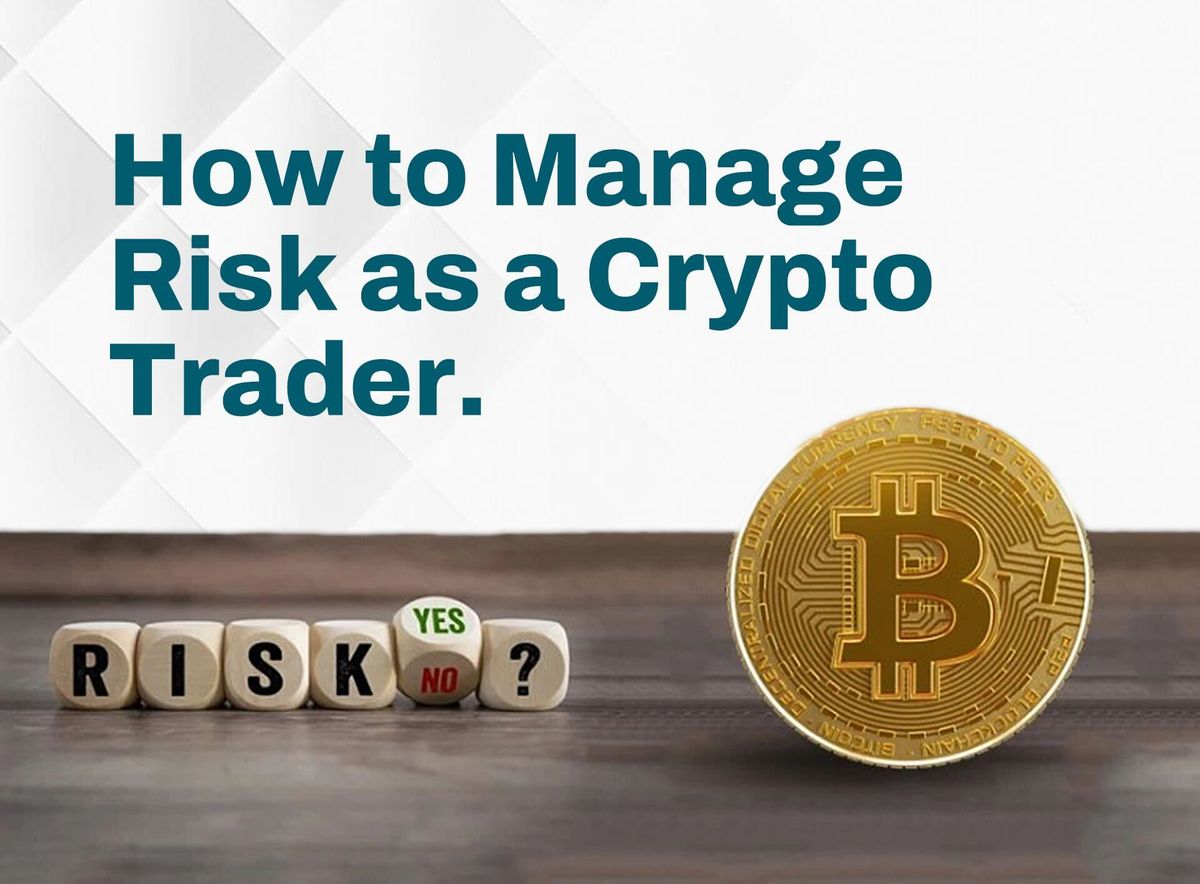How to Manage Risk as a Crypto Trader
Factors such as market sentiment, regulatory changes, and technological developments can influence prices, making crypto trading risky. As a trader, it's necessary to recognise these risks and implement strategies to reduce potential losses.

TABLE OF CONTENT:
1. Introduction
2. Understanding the Risks
3. What are the Risks in Crypto Trading?
4. How to Manage Risks as a Crypto Trader
5. The Importance of Managing Risks in Crypto Trading
6. Closing Thoughts
7. FAQs
In this article, we'll explore the fundamentals of risk management in cryptocurrency trading, providing you with simple yet effective strategies to safeguard your investments.
Understanding the Risks
Before delving into the different methods of managing risks as a crypto trader, it's important to understand the essential risks of crypto trading.
Cryptocurrency markets are known for instability, with prices fluctuating dramatically within short periods.
Factors such as market sentiment, regulatory changes, and technological developments can influence prices, making crypto trading risky.
As a trader, it's necessary to recognise these risks and implement strategies to reduce potential losses.
What are the Risks in Crypto Trading?
Crypto trading, while promising substantial returns, comes with its fair share of risks that every trader should be aware of.
1. High Instability:
Unlike traditional assets, the value of cryptocurrencies can experience wild fluctuations in short periods, leading to significant gains or losses. For instance, Bitcoin, the most well-known cryptocurrency, witnessed a staggering increase in value in 2021 but also had periods of sharp declines.
2. Scams and Fraud:
With the decentralised and pseudonymous nature of many cryptocurrencies, malicious actors can exploit unsuspecting traders. According to a report by the Federal Trade Commission (FTC), Since the start of 2021, more than 46,000 people have reported losing over $1 billion in crypto to scams. Traders must be cautious and conduct thorough research before engaging in any transactions or investments.
3. Security Concerns:
Hacks and security breaches in cryptocurrency exchanges have resulted in the loss of millions of dollars. In 2019, the largest cryptocurrency exchange, Binance, suffered a hack that led to the loss of $41 million worth of Bitcoin. Traders must prioritise the security of their digital assets by using reputable wallets like Obiex and implementing robust security measures, such as two-factor authentication.
4. Market Manipulation:
In rarely traded or smaller-cap cryptocurrencies, a single large trade can excessively impact prices, making these markets vulnerable to manipulation. Pump-and-dump schemes, where the value of a cryptocurrency is artificially inflated and then rapidly sold off, have been a recurring issue.
5. Regulatory Uncertainty:
Governments worldwide are still grappling with how to regulate and tax cryptocurrencies. Regulation changes can profoundly impact the market, affecting everything from the legality of specific tokens to the taxation of gains. Traders must stay informed about the regulatory landscape and be prepared for potential changes.
How to Manage Risks as a Crypto Trader
The following are risk management methods in crypto trading:
1. Diversification:
One of the primary principles of risk management is diversification. Instead of investing all your funds in a single cryptocurrency, spread your investments across multiple assets. This strategy helps reduce the impact of a poor-performing asset on your overall portfolio. Diversification is similar to not putting all your eggs in one basket, minimising the risk associated with the failure of a particular coin.
For example, imagine investing solely in a highly unstable cryptocurrency like Bitcoin. Your entire investment will be at risk if its price experiences a sudden and significant drop. Diversification allows you to hedge against such scenarios by holding various cryptocurrencies with different risk profiles.
2. Set Realistic Goals and Limits:
Establishing clear goals and limits is essential for any crypto trader. Determine your financial goals, risk tolerance, and time horizon before entering the market. This will help you create a well-defined trading plan with realistic expectations.
Let’s look at an instance. If your goal is to achieve a 20% return on investment, set a specific target and exit strategy. Additionally, establish stop-loss orders to sell your assets automatically if they reach a predetermined price, preventing further losses.
3. Risk-Reward Ratio:
The risk-reward ratio is a fundamental concept in risk management. It involves assessing the potential reward of a trade against the risk of possible losses. A favourable risk-reward ratio ensures that potential profits outweigh potential losses.
For instance, if you enter a trade with a risk-reward ratio of 1:2, you are potentially willing to risk $100 to gain $200. This ensures that even if only half of your trades are successful, you can still be profitable over the long term.
4. Risk Management Tools:
Utilise risk management tools provided by cryptocurrency exchanges to protect your investments. These tools include stop-loss orders, take-profit orders, and trailing stops, which automatically execute trades based on predetermined price levels.
Let’s look at an example for context. Setting a stop-loss order at 5% below your purchase price limits potential losses in case the market takes an unexpected turn. Similarly, a take-profit order can automatically sell your assets when they reach a predefined profit level.
5. Stay Informed and Stay Calm:
Remaining informed about market trends, news, and developments is essential for effective risk management. Stay up-to-date with the latest news and be aware of potential market-moving events.
Suppose a significant regulatory announcement is made regarding a particular cryptocurrency you hold. Being aware of such news allows you to make informed decisions, such as selling the asset before potential negative consequences unfold.
The Importance of Managing Risks in Crypto Trading
1. Protecting Your Investments: Imagine investing your hard-earned money in a new cryptocurrency, hoping it will skyrocket. While the potential gains are thrilling, the risks are equally high. Effective risk management acts as a shield, helping you protect your investments from sudden market downturns or unforeseen events.
2. Preserving Capital: Crypto markets are notorious for their instability. A single bad trade could wipe out a significant portion of your capital without proper risk management. By setting stop-loss orders and limiting the amount you risk on each trade, you ensure that your overall capital remains intact even if some trades go south.
3. Emotional Stability: Without a risk management strategy, emotions might dictate your decisions, leading to impulsive actions. Establishing clear risk parameters helps you stay calm and collected, preventing emotional reactions that could harm your portfolio.
4. Consistent Profits Over Time: Successful crypto trading is not about hitting home runs with every trade but about consistent, long-term gains. Risk management allows you to create a strategy focusing on steady profits while minimising the impact of occasional losses. It's about playing the long game.
5. Avoiding Margin Calls: Margin trading can amplify both gains and losses. Without proper risk management, you might find yourself in a margin call situation, where the exchange demands additional funds to cover potential losses. Effective risk management ensures you stay well within your means, avoiding such stressful scenarios.
6. Market Uncertainties: Cryptocurrency markets can be unpredictable. Regulatory changes, technological developments, and global events can significantly impact prices. By managing risks, you prepare for uncertainties, adapting your strategy to navigate the ever-changing crypto landscape.
7. Learning from Mistakes: Everyone makes mistakes, especially in the complex world of crypto trading. Risk management isn't just about avoiding losses but also about learning from mistakes. Analysing unsuccessful trades within a risk management framework helps you refine your strategy, turning setbacks into opportunities for growth.
Closing Thoughts
As a crypto trader, embracing a comprehensive risk reduction strategy involves a blend of research, diversification, and disciplined decision-making.
Keep a watchful eye on market trends, stay informed about the latest developments, and diversify your portfolio to spread risk effectively. Remember, successful crypto trading is not just about making profits but also about preserving capital.
By incorporating these risk management principles into your trading routine, you'll be better equipped to navigate the instability of the crypto market and position yourself for long-term success. Happy trading!
FAQs
Q1. How can I determine my risk tolerance?
A1. Assess your financial situation, including income, expenses, and emergency funds. Only invest what you can afford to lose without compromising your lifestyle.
Q2. What is the significance of stop-loss orders?
A2. Stop-loss orders automatically sell your assets at predetermined levels, preventing significant losses during market downturns.
Q3. Can diversification eliminate all risks?
A3. While diversification spreads risk, it doesn't eliminate it entirely. However, it does provide a safeguard against substantial losses from a single investment.
Q4. Is crypto trading suitable for beginners?
A4. Yes, but beginners should start small, educate themselves, and gradually increase their exposure as they gain experience.
Q5. How do I choose the right cryptocurrencies to invest in?
A5. Research each cryptocurrency's fundamentals, technology, and community support. Diversify your investments to mitigate specific asset risks.
Q6. Should I use leverage in crypto trading?
A6. Leverage amplifies both gains and losses. Approach it cautiously and only if you thoroughly understand the risks involved.
Q7. How often should I review and adjust my risk management strategy?
A7. Regularly review and adjust your strategy based on market conditions, personal financial changes, and lessons learned from past trades.
Q8. Can I recover from a significant loss in crypto trading?
A8. Recovery is possible with a disciplined approach to risk management, learning from mistakes, and staying patient during market fluctuations.
Q9. What role does market research play in risk management?
A9. Market research helps you make informed decisions, reducing the likelihood of unexpected events negatively impacting your investments.
Q10. Are there risk management tools on Obiex?
A10. Yes, Obiex provides various risk management tools, including stop-loss orders and real-time market data, to help traders make informed decisions.
Disclaimer: This article was written by the writer to provide guidance and understanding of cryptocurrency trading. It is not an exhaustive article and should not be taken as financial advice. Obiex will not be held liable for your investment decisions.




